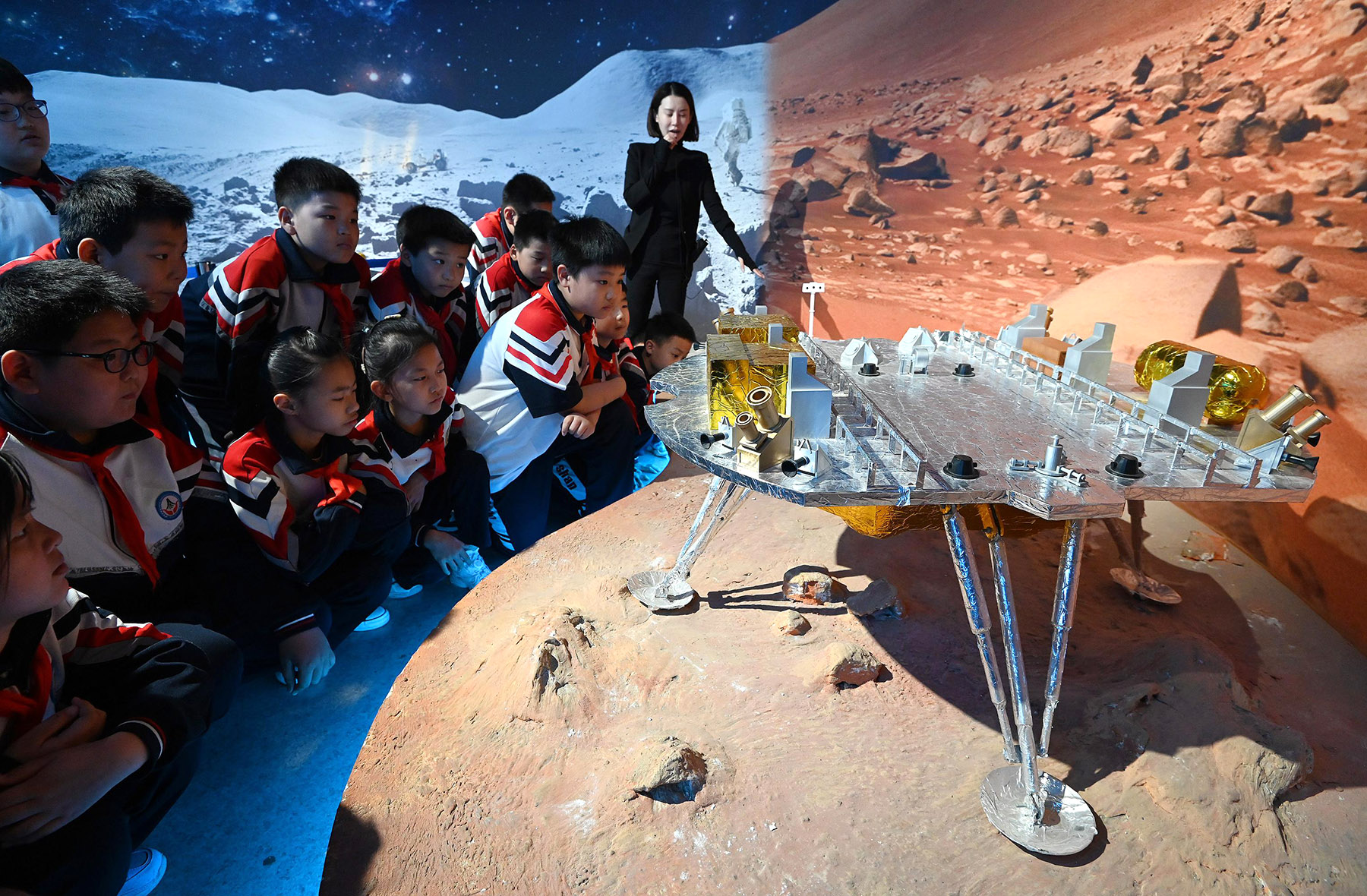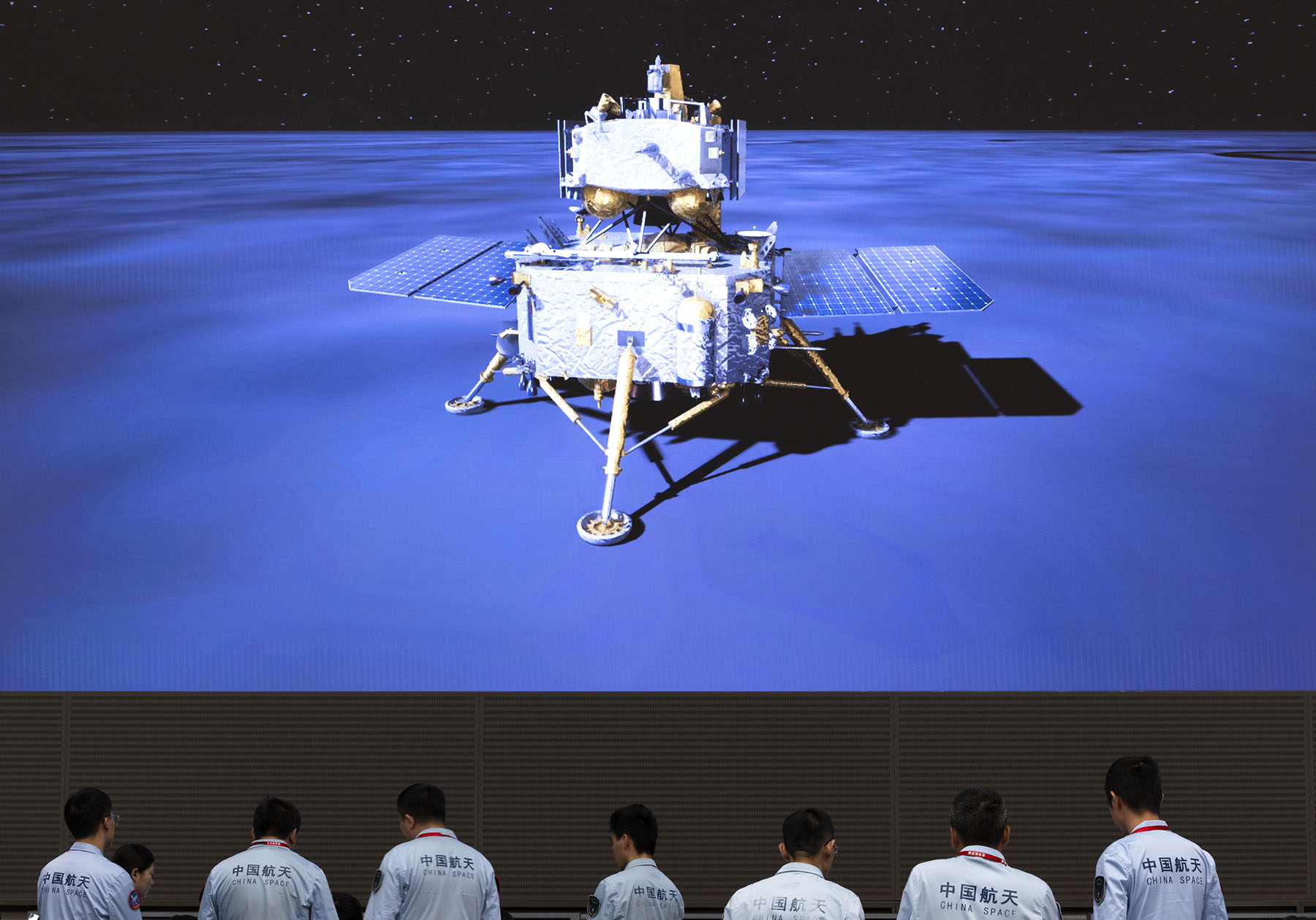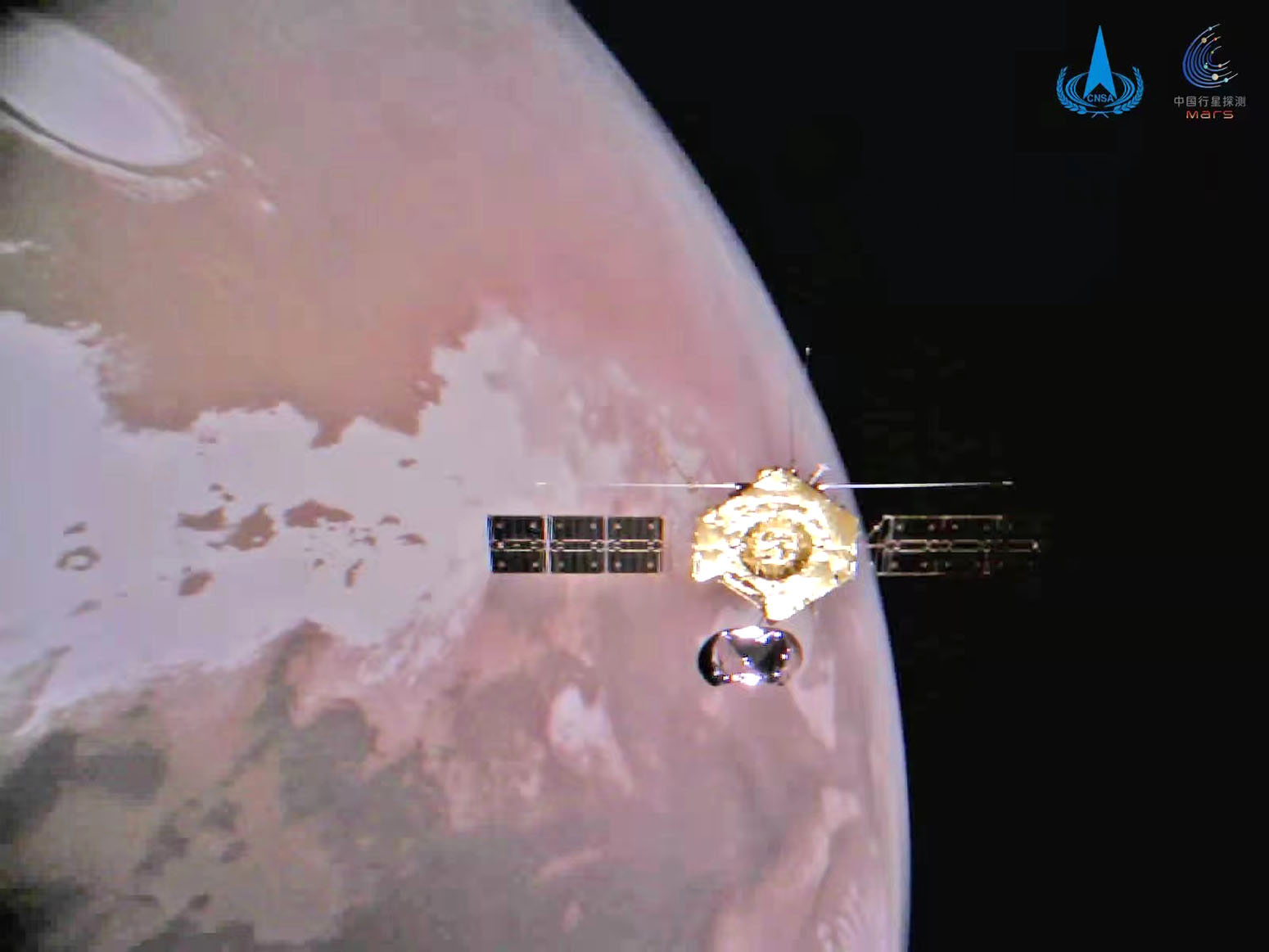More space missions planned, including a manned trip to the moon and one that would bring back samples from Mars

Editor's Note: China has always adhered to exploring and utilizing outer space for peaceful purposes. In recent decades, China's aerospace development has entered the "fast lane", seeing remarkable achievements in terms of space exploration. Thursday marks China's 10th Space Day. China Daily presents a special report on the nation's achievements in the field.
China's first asteroid sample-return mission, Tianwen 2, is scheduled to be launched in the coming weeks from the Xichang Satellite Launch Center in Sichuan province.
The robotic probe has been undergoing prelaunch functional checks at the mountainous spaceport since it arrived in late February, according to the China National Space Administration.
Mission planners have said that Tianwen 2, the country's second interplanetary expedition, will target 2016 HO3, the smallest and closest quasi-satellite to Earth.
READ MORE: Space Agency: China to carry out intensive space missions in 2025
The basic plan is to use a big carrier rocket to send a probe comprising two parts — an orbiter and a reentry module — toward the asteroid.
After approaching 2016 HO3, the unmanned spacecraft will orbit the asteroid for months and then fly very close to it to use a mechanical arm to scoop dust from the surface.
Next, Tianwen 2 will fly back to Earth's orbit and release its reentry module, which will return to the ground with the samples. The orbiter will then embark on a new journey toward a main-belt comet called 311P to continue its scientific exploration tasks.
2016 HO3, also known as 469219 Kamo'oalewa, was first spotted in April 2016 by an asteroid survey telescope at the Haleakala High Altitude Observatory in Hawaii.
The celestial body orbits the sun, so it remains a constant companion of Earth. It is too distant to be considered a true satellite of Earth, but it is the best and most stable example to date of a near-Earth companion, or quasi-satellite. Scientists believe that it contains clues to the solar system's early history, including its original composition and the process of its formation and evolution.
So far, scientists have identified about 1 million asteroids in the solar system, with more than 20,000 traveling near Earth.
Meanwhile, 311P is part of the main asteroid belt between Mars and Jupiter. Its physical composition is like those of comets, but its orbital characteristics resemble those of asteroids, according to astrophysicists.
Studying the comet will help researchers learn more about the composition, structure and evolution of small celestial bodies, thus leading to more knowledge about such objects in the solar system, CNSA officials have explained.
According to mission planners, the Tianwen 2 will be characterized by its complexity, challenges and long duration. The expedition, which will be the first in which China attempts to recover samples from an asteroid, is expected to last several years.
Tianwen missions, named after an ancient Chinese poem, cover China's interplanetary exploration endeavors.
Tianwen 1 was launched in July 2020, and it successfully touched down on Mars in May 2021. The probe deployed a rover, named Zhurong, to explore the Red Planet. Zhurong was the sixth rover on Mars, after five that were deployed by the United States.

Martian adventure
After the Tianwen 2 mission, China plans to launch the Tianwen 3 robotic craft around 2028. That mission is expected to bring Martian soil back to Earth around 2031.
Chinese researchers are working on essential technologies to be used in the expedition, including sampling and liftoff devices, on the Martian surface, according to the CNSA.
The Tianwen 3 probe will have four components — a lander, an ascender, an orbiter and a reentry module — and will be launched on two Long March 5 heavy-lift carrier rockets from the Wenchang Space Launch Center in Hainan province.
The lander and ascender will take an Earth-Mars transfer trajectory and carry out orbital correction maneuvers before entering Martian orbit, after which they will attempt an engine-assisted soft-landing.
Meanwhile, the orbiting stack — the orbiter and reentry module — will follow the same path to reach Martian orbit, after which they will fly around Mars to relay signals and wait for the samples.
Once the samples are collected and packed into a vacuumed metal container, the ascender's engines will elevate it to orbit to rendezvous and dock with the reentry module, transfer the samples and undock.
The orbiting stack will then leave Martian orbit and return to Earth's orbit, where the pair will break up and the reentry module will conduct a series of complicated maneuvers to return to a preset landing site.
Scientists at the Deep Space Exploration Laboratory in Hefei, Anhui province, a major research and engineering body in China's interplanetary study community, have proposed 86 potential landing sites on the Red Planet, primarily concentrated in the ancient Chryse Planitia and Utopia Planitia regions, which encompass diverse geological environments such as ancient coastlines, deltas, ancient lakes and canyon systems, providing favorable conditions for the origin and preservation of potential ancient life, according to an article published in the November edition of the academic journal National Science Review.
Yang Yuguang, a senior space industry observer and chair of the International Astronautical Federation's Space Transportation Committee, explained that any country wishing to bring samples back from Mars will need to overcome many extremely difficult issues.
For instance, he said, engineers will need to build and launch a massive spacecraft, which will be able to lift off from the Martian surface to send samples to Martian orbit.
Meanwhile, landing such a big vessel safely on the Martian surface would be exceptionally challenging, given that landing on Mars is far more difficult than a lunar landing due to the complex atmosphere surrounding the barren planet, Yang said.
Even if an ascending craft could land on Mars and later lift off, he said there would be a new challenge — how to guide it to carry out an accurate rendezvous and docking with the orbiter flying around the planet to wait for samples.
Designers will have to figure out a solution to lead the sample-loaded ascender to find and connect with the orbiter without any Earth-based telemetry support, according to the expert.
If everything goes according to plan, the samples could become the first to be returned to Earth from Mars. They will help scientists identify traces of life on the Red Planet, learn more about the planet's geology and inner structures and understand its atmospheric cycles.
Space officials said China is open to cooperation with foreign scientists working on the Tianwen 3, encouraging them to take part in payload design, and sample and data analysis.
Chang'e missions
In terms of lunar exploration, China plans to maintain its lead in the field of robotic expeditions with two ambitious missions — Chang'e 7 and 8 — before landing Chinese astronauts on the silver sphere.
Chang'e 7, set for launch around 2026, is tasked with exploring the environment and resources, especially for traces of water, on the south pole of the moon.
The Chang'e 7 probe will consist of an orbiter, a lander, a rover and a small flying probe designated to fly into pits on the lunar surface to look for ice.
Wu Weiren, an academician of the Chinese Academy of Engineering and chief planner of the nation's lunar programs, said: "There are some deep caves at the lunar south pole where we believe water might exist. However, these areas are permanently shaded from sunlight — if exposed to sunlight, the water would vaporize. Under permanent shadow, the water is likely to exist in the form of ice. We want Chang'e 7 to have a flying craft that, after landing, can fly into one or two of these caves for on-site exploration to see if water can be found."
Scientists have explained that the presence of water, in the form of ice, could significantly reduce the costs and time required to transport water from Earth to the moon, thus facilitating the establishment of human presence and long-term activities on the moon.
On the other hand, if water can be found on the moon, it will hold important clues to determining whether life exists on the moon and other planets.
To make the best use of opportunities in the Chang'e 7 mission and better cooperate with international partners to explore the moon, the space administration announced in November 2022 that it would invite international payloads on the Chang'e 7 probe and began soliciting proposals.
Upon ending the solicitation process in January 2023, it had received 18 proposals from 11 countries and international organizations.
Based on the proposals' scientific objectives and engineering feasibility, six payloads submitted by six countries — Egypt, Bahrain, Italy, Russia, Switzerland and Thailand — as well as the International Lunar Observatory Association, have been selected to be carried on the Chinese probe.
After the Chang'e 7 mission, China aims to launch Chang'e 8 around 2028. Chang'e 8 will also land on the lunar south pole to conduct experiments for the in-situ utilization of lunar resources.
Components of the two Chang'e missions will become the basis for an ambitious multinational project initiated by China known as the International Lunar Research Station.
A number of nations, including Venezuela, South Africa and Pakistan, as well as international organizations such as the Asia-Pacific Space Cooperation Organization and the Arab Union for Astronomy and Space Sciences, have signed up to participate in the project.
So far, China has conducted six robotic missions to explore the moon.
The country deployed two rovers on the lunar surface during the Chang'e 3 and 4 missions. It has also retrieved samples from both the near and far sides of the moon via the Chang'e 5 and 6 missions, becoming the first and only nation to have achieved such a historic feat.

Manned moon trip
Having gained rich experience through the robotic missions, China has been moving progressively toward its goal of sending astronauts to the moon around 2030, with all research and construction work advancing as planned, according to the China Manned Space Agency.
The agency said that key components of the ambitious project, including the Long March 10 heavy-lift carrier rocket, the Mengzhou manned spacecraft, the Lanyue lunar lander, the Wangyu lunar suit and the Tansuo crew rover, are currently in the preliminary prototype development phase, and the design work is proceeding on schedule.
Meanwhile, construction of new testing and launch facilities is underway at the Wenchang Space Launch Center in Hainan province. The overall design plans have been finalized for the tracking, telemetry and command systems, as well as landing site infrastructure, and construction work is set to begin imminently, according to the agency.
Once the mission is achieved, China will become the second nation to land astronauts on the moon, significantly boosting its global space standing.
The US successfully conducted six Apollo crewed missions in the 1960s and 1970s, bringing 12 Americans to the silver celestial body.
The country's road map for its first manned lunar expedition involves two Long March 10 launches from the Wenchang spaceport to transport a Lanyue lunar lander and a Mengzhou manned spacecraft to lunar orbit.
After reaching their preset orbital positions, the Lanyue lander and the Mengzhou vessel will rendezvous and dock. Two crew members will enter the lander, which will then undock and descend toward the lunar surface for an engine-assisted soft landing.
On the moon, the astronauts will drive a Tansuo rover to carry out scientific tasks and collect samples. Upon completion of their assignments, they will return to the Lanyue module, which will fly them back to their spaceship waiting in lunar orbit.
In the final stage, the astronauts will carry samples into the Mengzhou spacecraft, which will then undock and carry the crew back to Earth.
To prepare for the sophisticated adventure, China has selected its fourth group of astronauts, who are currently training for lunar landing and surface operations.
Next-generation Beidou
China has planned to establish a next-generation space-based navigation and positioning system by 2035, according to project managers.
The new version of the Beidou system will be "omnipresent, smarter and more integrated", and upon its completion in 2035, there will be Beidou service not only on land and sea, but also in the sky, outer space and deep within the oceans, said Yang Changfeng, chief planner of the Beidou program.
Beidou is China's largest civilian satellite system and one of four global navigation networks, along with the US' GPS, Russia's GLONASS and the European Union's Galileo.
ALSO READ: Out of this world
Since 2000, a total of 64 Beidou satellites, including the first four experimental ones, have been lifted on 47 Long March 3 series rockets from Xichang.
In July 2020, the system was declared complete and began providing full-scale global services. Currently, there are more than 50 Beidou satellites in active service, operating in multiple types of orbits.
According to most recent statistics published by the Global Navigation Satellite System and Location-Based Services Association of China, the total output value of the nation's satellite navigation and positioning services industry reached 536.2 billion yuan ($73.8 billion) in 2023, up 7.09 percent year-on-year.
By the end of 2023, more than 500,000 Chinese people had worked at around 14,000 domestic institutes and companies doing business related to Beidou and other satellite navigation and positioning services, according to the association.
zhaolei@chinadaily.com.cn


